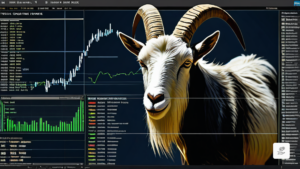The Art of Adaptability: Navigating Market Complexities and Maximizing Trading Success

Embracing the Dynamic Nature of the Financial Markets
In the realm of trading, the ability to adapt is paramount. Just as Charles Darwin’s famous quote suggests, it’s not the strongest or most intelligent who thrive, but those who can nimbly adjust to the ever-changing landscape of the financial markets. This article delves into the crucial importance of aligning your trading strategy with the complexities of the market, exploring the different types of market conditions and providing actionable strategies to maximize your success.
Deciphering the Market’s Elusive Language
UProfit’s Five Pillars of Mastery: Adapting to the Ebb and Flow of Markets

- Deciphering market conditions: understanding the elusive language of the market
- Trending markets: take advantage of the wave of momentum
- Markets in range: exploit the swings
- High Volatility Markets: Embracing the Thrill of Uncertainty
- Adapting your strategy: a journey of continuous evolution
Understanding the different market conditions is the cornerstone of successful trading. Each type of market presents unique opportunities and challenges, and traders must be equipped to recognize and adapt to these nuances. By embracing this knowledge, traders can capitalize on favorable market conditions while mitigating risks during more turbulent times.
Trending Markets: Riding the Wave of Momentum
Trending markets are characterized by a sustained and consistent movement in a particular direction. Identifying the trend and aligning your trading strategy accordingly can lead to significant profit potential. Whether it’s an uptrend or a downtrend, traders can capitalize on the momentum by entering long or short positions, respectively.
Ranging Markets: Exploiting the Oscillations
Ranging markets, also known as sideways or consolidating markets, present a different set of challenges and opportunities. In these markets, prices fluctuate within a relatively narrow range, lacking a clear upward or downward trajectory. By identifying support and resistance levels, traders can take advantage of price oscillations within the established range, buying at or near support levels and selling at or near resistance levels.
High-Volatility Markets: Embracing the Thrill of Uncertainty
High-volatility markets are characterized by significant price fluctuations and increased uncertainty. These markets can be both exhilarating and daunting, but traders who can navigate the volatility can reap substantial rewards. Short-term trading strategies, such as scalping or day trading, are often ideal for high-volatility markets, allowing traders to take advantage of short-lived price fluctuations.
Unveiling the Forces that Shape Market Conditions
To effectively adapt your trading strategy, it’s essential to be aware of the factors that can cause markets to change. These factors include economic data releases, news events, herd behavior, central bank policies, and market sentiment. By staying informed about these factors, traders can anticipate potential market movements and adjust their strategies accordingly.
Adapting Your Strategy: A Journey of Continuous Evolution
UProfit’s Five Pillars of Mastery: Adapting to the Ebb and Flow of Markets

- Deciphering market conditions: understanding the elusive language of the market
- Trending markets: take advantage of the wave of momentum
- Markets in range: exploit the swings
- High Volatility Markets: Embracing the Thrill of Uncertainty
- Adapting your strategy: a journey of continuous evolution
Adapting your trading strategy to different market conditions is a continuous process that requires a combination of technical analysis, fundamental analysis, and risk management strategies. By embracing the right technical analysis tools, staying informed through fundamental analysis, and implementing proper risk management strategies, traders can navigate changing market dynamics, protect capital, and increase the chances of achieving their trading goals in a consistent and controlled manner.
Technical Analysis: Unraveling the Market’s Secrets
Technical analysis involves studying historical price data to identify patterns and trends. By using the right technical analysis tools, traders can gain valuable insights into market sentiment, volatility, and potential price reversals. Different market conditions require different technical analysis tools, and traders must be proficient in selecting the appropriate tools for each scenario.
Fundamental Analysis: Delving into the Underlying Value
Fundamental analysis involves examining economic data, company earnings reports, industry trends, and market news to evaluate the underlying value of an asset. By staying informed and conducting thorough research, traders can gain valuable insights into the factors that drive market movements. This information allows traders to make informed decisions and adapt their trading strategies accordingly.
Risk Management: The Art of Preserving Capital
Effective risk management is the cornerstone of successful trading. By implementing proper risk management strategies, traders can mitigate risk, protect capital, and increase the chances of long-term profitability. These strategies include setting stop-loss and take-profit levels, adjusting trade size based on market conditions, and avoiding overtrading. Traders who effectively manage risk are better positioned to navigate various market conditions and achieve their trading goals in a consistent and controlled manner.
Conclusion: Embracing the Dynamic Symphony of the Markets
Adaptability is the lifeblood of successful trading. By understanding market conditions, using the right technical analysis tools, staying informed through fundamental analysis, and implementing proper risk management strategies, traders can navigate the ever-changing landscape of the financial markets. This approach empowers traders to capitalize on favorable market conditions, mitigate risks during challenging times, and ultimately increase their chances of achieving their trading goals.




